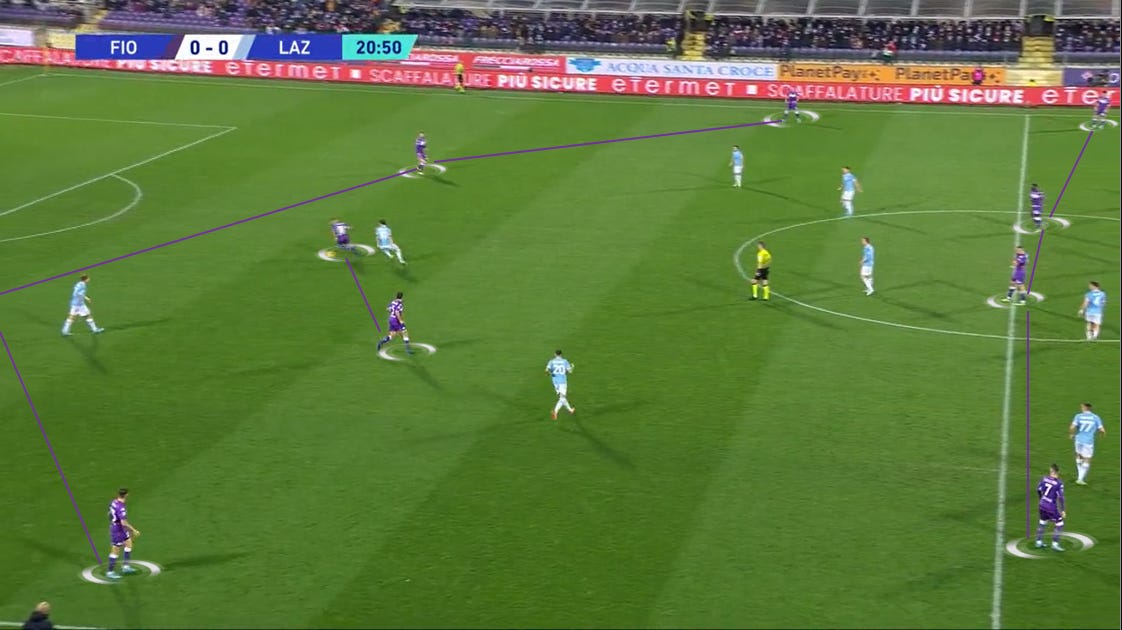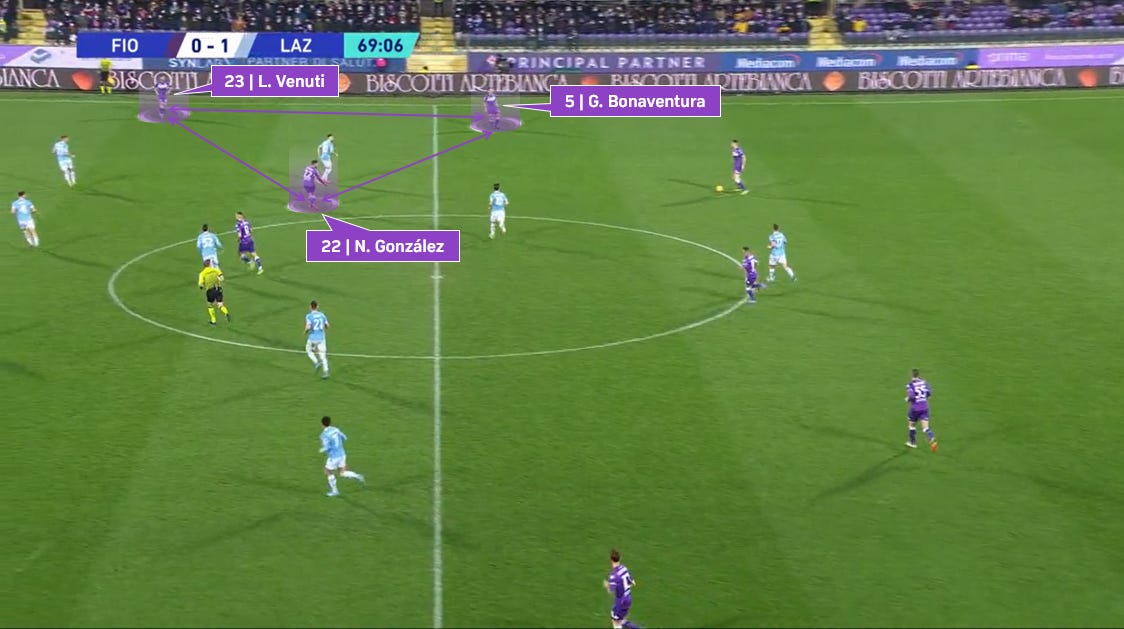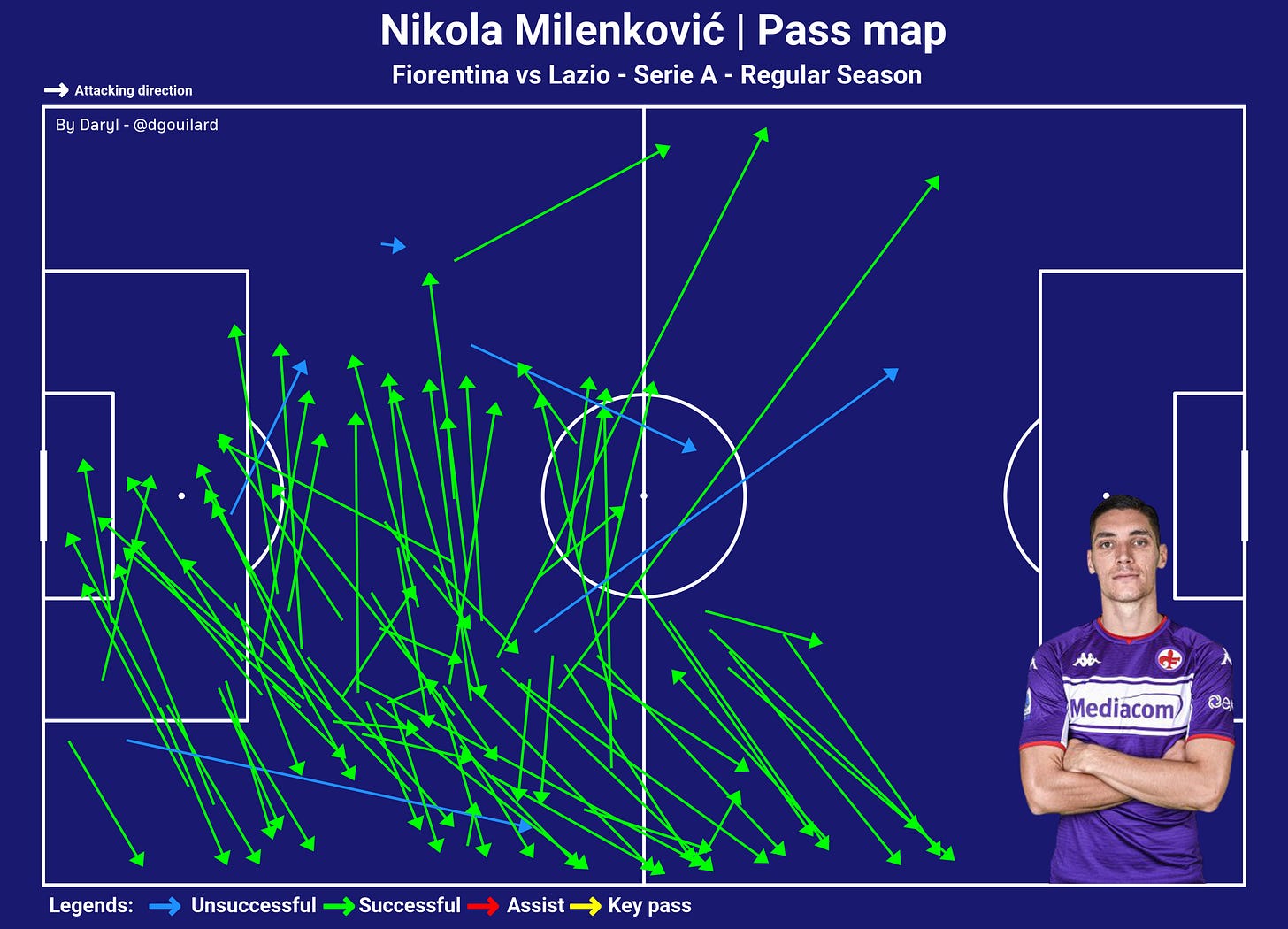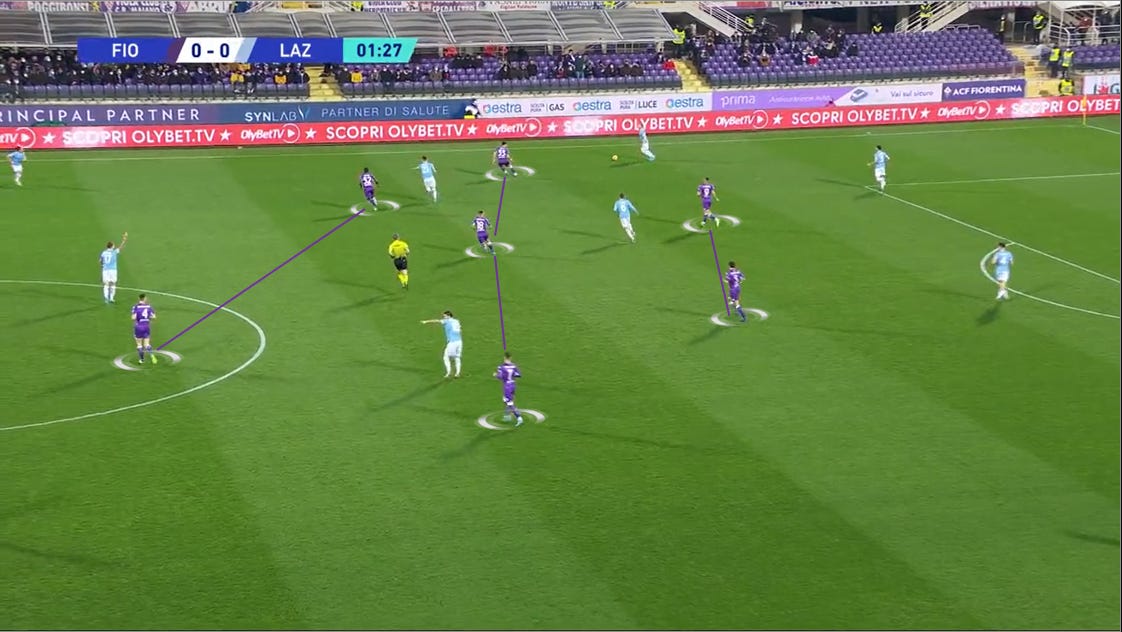[Match analysis] Fiorentina vs Lazio: More than just a 4-3-3
A quick analysis of how Fiorentina and Lazio use the 4-3-3 to their advantages and how Lazio came out on top by capitalising the weaknesses of Fiorentina's tactics.
(-All stats used in this article are from Serie A’s official match report: [https://www.legaseriea.it/en/match-report-pdf/A/2021-22/UNICO/UNI/24/FIOLAZ]
-All vizzes used in this article are made from Opta’s data and by Python and Matplotlib)
The 4-3-3, or 4-1-4-1 depends on how one sees it, is a versatile formation that can adapt to the coach’s preferred way to play. It is also a balanced formation since it allows for the creation of triangles across the pitch to support a team’s transitioning and offensive phases, a philosophy that has been made popular during Pep Guardiola’s tenure at Barcelona. It can also be seen as a defensive formation since a 4-1-4-1 allows a team to have two defensive lines of four and a defensive midfielder protects the space in between both defensive lines. This is an effective formation for teams that defend in a low block with the aim of preventing the opposition from entering the defensive third.
Two managers who have been utilising the versatility of the 4-3-3 effectively this season are Fiorentina’s Vincenzo Italiano and Lazio’s Maurizio Sarri. After coming in to replace Giuseppe Iachini and Simone Inzaghi at their respective clubs, both Fiorentina and Lazio under the guidance of their new manager are having a decent season with both teams are still in the race for a European spot. During the first weekend of February and under the lights of the Artemio Franchi, both teams met each other and showcased the differences in the way that both managers viewed the 4-3-3 formation. At the end, Lazio came out on top by making the most of Fiorentina’s errors and weaknesses. So, how did Sarri’s side adapt to Italiano’s style of play? And what are the tactical characteristics of both teams?
A cautious first half
The answer to the second question was shown clearly during the first 35 minutes of the match, the period where both teams played with their own style and still tried to find the weaknesses of the opposition. On paper, both Fiorentina and Lazio seemed to lineup in a 4-3-3 formation as usual. But modern football has taught us one thing, which is the importance of formations is not as significant as it is used to be consider. What happens on the pitch is more than what a team’s formation can portrait, as teams can flexibly interchange between one formation and the others depending on the phase of play or the way the opposition are playing. And that was exactly what happened on the pitch of the Artemio Franchi.
When Fiorentina played out from the back, they looked to be playing out with a 4-2-4 formation with Lucas Torreira dropping close to the back four to take on the role of a ball progressor. Usually, the Uruguayan midfielder would receive the support of Giacomo Bonaventura, especially when the team tried to attack down the right-hand side. Meanwhile, Alfred Duncan would stay in behind Lazio’s midfielders to create a front four for a 4v4 situation against Lazio’s back four. When they attacked down the left-hand side, Bonaventura and Duncan’s roles would be reversed, with the former staying high and the latter dropping deep to support Torreira and the back four.
Fiorentina are an extremely wing-oriented side as 17 out of their total 21 attacking plays in this match happened down either flank (10 down the left, 7 down the right) and they rely on crosses or individual abilities of the full-backs and the wingers to deliver the ball into the box. This tactic worked well when they had Dušan Vlahović at the central of every attack and it also explained why they went for two strikers with a similar profile to Vlahović in Arthur Cabral and Krzysztof Piątek during the winter transfer window.
With Vlahović, Cabral and Piątek, Fiorentina had and have strikers who are strong in the air and can hold off the challenge from the opposition’s defenders to meet the crosses that Cristiano Biraghi and Nicolás González will deliver from both the left- and right-hand side. It does not come as a surprise to know that Fiorentina have completed the second-most crosses in Serie A with 170 crosses completed (behind Inter’s 176) and Biraghi is currently joint-eighth for key passes made with a total of 38.
It is also worth noticing that when they played out from the back, Fiorentina’s full-backs and wingers looked to stay very wide rather than sit narrow to narrow the distance between them and Torreira and Bonaventura. Not only did this strategy allow Fiorentina to stretch the play and support their preference to attack down both flanks, but it also supported Italiano’s idea of creating passing triangles when moving the ball down the wing.
There were occasions that Fiorentina’s wide players would swap positions with each other when the team were trying to progress the ball forward, which usually took place on the right-hand side. Right-back Lorenzo Venuti would usually position himself inside the right half-space while right winger José Callejón would stay wide in order to stretch the play. When Nicolás González came on for Callejón in the second half, the positional rotation now included Bonaventura where the former Milan midfielder would drop into Venuti’s position, González would move to the space in between Lazio’s defensive lines and Venuti stayed on the shoulder of Lazio’s left-back.
As mentioned, Torreira’s role during the team’s build-up was a ball progressor for the team. He would usually receive the ball from the centre-backs then either made a pass or carried the ball towards Duncan or Bonaventura, who had already positioned themselves close to the positions of the full-back and the winger. This allowed for quick transition from the build-up phase to the offensive phase where Fiorentina would rely on the dribbling ability of the wingers, in this match were Riccardo Sottil and José Callejón, to progress the ball into Lazio’s half.
(The sizes of the circle indicates the number of successful passes made by the player)
Torreira was not the only player who could carry the ball forward to the wide players as the Serbian centre-backs were also doing the same thing on numerous occasions. Matija Nastasić and Nikola Milenković would carry the ball into the wide space and look to create a passing triangle with the nearest players to them, which were usually the full-back and the central midfielder or the winger from the same side.
If they were unable to do so, one centre-back would pass the ball to the other in order to switch the attacking focus onto the opposite side. This is also one of Fiorentina’s attacking preferences as they usually look to switch the play quickly through the least amount of passes as possible. The aim is to attack the space on the opposite wing where the opposition are unable to cover since their defensive lines have been shifted to one side of the pitch, allowing for Fiorentina’s winger on the opposite wing to find himself in plenty of space for a pass, a cross or even a shot by himself. Again, if the opposition are quick enough to shift their defensive lines to the other side, which Lazio managed to do on plenty of occasions (we will get to this later on), the nearest central midfielder would usually offer a safe passing option to allow the team to restart the attack.
With a possession and wing-oriented approach, Fiorentina dominated the first 30 to 35 minutes of the match and kept Lazio inside their own half for the majority of the period. They have also created several dangerous attacking plays and ended up with three shots towards Lazio’s goal, one of them was Cabral’s header but it was saved by Strakosha. Still, they were the better team in the majority of the first half in terms of expected goals since their created chances accumulated to 0.5 xG while Lazio’s xG was slightly lower with 0.44 xG.
Lazio had a similar approach to Fiorentina as they were also a possession-oriented side. During the build-up phase, the away side also looked to have one midfielder, Lucas Leiva, to drop close to the back four and progress the ball while another midfielder, Luis Alberto, moved flexibility between dropping back to support Lucas and the back four and moving forward to act as a second striker behind Ciro Immobile. While not having as many key passes as Biraghi (Alberto has made 28 key passes this Serie A season), Alberto is currently sixth on the assists leaderboard with 6 assists to his name and he has also created 34 goal-scoring chances for his teammates.
While Luis Alberto has been in good form this season, Sergej Milinković-Savić is the player that should be focused on. Under Sarri this season, the Serbian midfielder has transformed himself from a midfielder into a hybrid player who can play both as a midfielder and a second striker behind Immobile. He was the key for Lazio during their transition phase from build-up to attack as he looked to create a front four with the attacking trio up front. His presence up top also allowed Immobile to drop deep and receive the ball whenever it was possible for the Italian international. Milinković-Savić would usually attack the space that Immobile created from deep, allowing Alberto to find him with a lofted pass over the top of the opposition’s defence and led to an attacking situation where the opposition could find themselves being outnumbered.
The positioning of both wingers, in this match were Pedro and Mattia Zaccagni, also supported Lazio during the attacking situation. Both players would usually stay wide in order to prevent the opposition full-backs from moving inside to support the defensive situation. If they did end up doing so, Pedro and Zaccagni would still be able to provide a passing option out wide should the rest of the team looked to switch the play. With the full-backs already moved inside to support the defensive situation, Lazio’s wingers would be unmarked when they received the ball, allowing them to carry the ball forward into the final third.
This was where Lazio tried to hit Fiorentina the hardest. Knowing that Fiorentina preferred to press very high up the pitch and raised their defensive line high to support the press (Fiorentina’s average position of the defensive line without the ball was 43,55m or 48,11 yards from their goal), Lazio played through Fiorentina’s press and looked to attack the space behind the opposition’s last defensive line with numerical superiority.
One of Fiorentina’s pressing characteristics that Lazio used as their advantage was the opposition tended to commit players forward to press. When out of possession, Fiorentina tried to press in a 4-1-3-2 or a 3-2-3-2 formation with Bonaventura moving forward to create the first pressing lane alongside Cabral while both wingers and Torreira created the second lane. The intention was to match Lazio’s number and tried to overwhelm the away side while they were playing out from the back, forcing them to play long balls forward and Fiorentina’s centre-backs would be able to win the second balls.
Another of Fiorentina’s pressing characteristics was to have one player marking Milinković-Savić all the time. Lazio used a similar strategy in the first fixture between both teams this season and it caught Fiorentina off guard. But they had a plan for this match by having Alfred Duncan, and Gaetano Castrovilli in the second half, marking Lazio’s number 21 for the majority of the match to limit his influence on the game. But both of these characteristics later came back to haunt Fiorentina, especially inside the second half, which is also a good time to answer the first question that was asked at the beginning of this article.
Lazio’s second-half response
While dominating the first half, Fiorentina could not find the opening goal that they wanted due to Lazio’s well-organised defence, and they were forced to enter the half time without any rewards for their effort. On the other hand, Sarri had already come up with a plan to hit Fiorentina where they could potentially be hit the hardest, counter-attacks and long passes.
From Strakosha’s long ball towards the left-hand side, Immobille, Zaccagni and Alberto teamed up down the left wing and that attracted Fiorentina’s attention, leaving the central area with only 3 players to mark. Milinković-Savić was the only Lazio player that attacked down the central area, and he was also marked by Duncan at the same time. But when he entered the final third, no one was able to close him down as he entered the channel between Milenković and Biraghi since Milenković was already covering Nastasić and Biraghi thought Duncan would follow Lazio’s midfielder all the way. The misunderstanding between all three of Fiorentina players allowed Milinković-Savić to enter the 16-yard box without being marked, received Zaccagni’s through ball with ease, and he finished the attacking situation with a first touch shot through Pietro Terraccino.
That was one of Fiorentina’s defensive strategies being undone by Lazio since Italiano knew Milinković-Savić would be very dangerous when he moved forward into a forward role, and he instructed Duncan to mark him to limit his influence on the match. Yet, this goal highlighted the exact thing that Italiano did not want to see, and it came from a misunderstanding between Duncan and Biraghi. But this was not the only goal that Lazio capitalised on Fiorentina’s defensive weaknesses.
Lazio’s second goal came after 20 minutes from the first goal, and it highlighted the weakness of Fiorentina’s 3-2-3-2 pressing formation. Throughout the match, it is possible to notice that Milenković tended to step out from his position to mark Luis Alberto, and he left Nastasić alone to deal with Immobile. With Castrovilli, who came on for Duncan, already responsible for marking Milinković-Savić and both full-backs had to stay wide to mark Lazio’s wingers, Nastasić found himself in a 1v1 situation with Immobile on several occasions, including in Lazio’s second goal.
Once again, the goal started from a long ball that was made from inside Lazio’s 16-yard box, and it was a harmless long ball from Patric. But Immobile was quick to challenge Nastasić for the long ball and his challenge made the Serbian centre-back missed the header to clear Patric’s long ball. The rest of the situation was too easy for a striker of Immobile’s calibre as he picked up the ball and faced Terraccino in a 1v1 situation, where he scored Lazio’s second goal from a finesse shot into the bottom right corner.
The third goal was more of a combination between the first and the second goal, starting from Lazio’s build-up situation down the left-hand side that attracted the intention of Fiorentina players. The home side tried to overload the area and win the ball back, but they could not. Meanwhile, Immobile tried to attack down the central area and, once again, Nastasić lost track of him, allowing the Italian striker to pick up Zaccagni’s through ball and ran freely towards Fiorentina’s 16-yard box. After rounding Terraccino, Immobile crossed the ball towards Felipe Anderson but Biraghi tried to intercept the cross and ended up sending the ball into his own goal.
Lazio did not create as many attacking plays as Fiorentina (17 to 21), but they were more clinical and lethal in capitalising Fiorentina’s weaknesses in defence. They finished the match with more attempts in total (12 to 9) and more attempts on target (7 to 3). At the other end, Lazio also defended well to prevent Fiorentina from getting the ball into the box. They used plenty of tactical fouls to frustrate the Viola players and disrupt their attack before they could get to the final third, which is reflected through their number of fouls committed (15).
Knowing Fiorentina’s preference to attack down the flank, Lazio tried to outnumber the home side by having four players involving in the defending situation, creating a square where two players would try to press the ball carrier and the nearest passing option while the other two providing coverage behind their backs. This forced Fiorentina to restart their attack on several occasions as they had no option but to pass the ball back to the centre-backs. They could not switch the play either due to Lazio’s numerical superiority inside of their own defensive third, which allowed the away side to have players at the far post to defend against any long balls coming from the opposite side.
This explained why most of Lazio’s defensive actions took place not only inside of their own box, but also down both flanks.
Conclusion
The clash between Fiorentina and Lazio offered a good tactical insight into two different, but also similar, ways to view the 4-3-3 formation. Both teams highlighted one of the lessons of modern football, which is versatility, as they switched between different formations during different phases of play rather than using solely the 4-3-3. Lazio also showed the clinicality in using their own style of play to provoke Fiorentina’s weaknesses and used such weaknesses to create goal-scoring chances.
It does not come as a surprise when the teacher, Sarri, came out on top once again in this season against the apprentice, Italiano. The former Chelsea manager showed his experience and the ability to adapt to the opposition’s tactics in order to find the edge that they need to gain all three points. In the end, both Lazio and Fiorentina will continue to be the teams to watch for the remainder of the Serie A season as both teams continue their pursue for a European place next season.

















